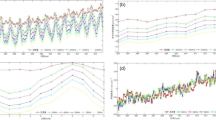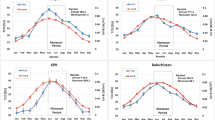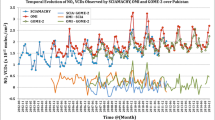Abstract
This chapter deals with the distribution and recent changes of tropospheric formaldehyde as measured from space borne sensors aboard Aura/OMI satellite of 0.1° × 0.1° spatial resolution during 2008–2018 over South Asia. The concentration of formaldehyde is mainly concentrated in the Indo-Gangetic Plains of South Asia spanning Afghanistan, Bangladesh, Bhutan, India, Nepal, Pakistan and Sri Lanka. Thiel-Sen’s analysis indicates a decreasing trend (−0.004 DUyr−1) during the study period.
Access this chapter
Tax calculation will be finalised at checkout
Purchases are for personal use only
Similar content being viewed by others
References
Abbot DS, Palmer PI, Martin RV, Chance KV, Jacob DJ, Guenther A (2003) Seasonal and interannual variability of North American isoprene emissions as determined by formaldehyde column measurements from space. Geophys Res Lett 30(17). https://doi.org/10.1029/2003gl017336
Alpert P, Osetinsky I, Ziv B, Shafir H (2004) A new seasons definition based on classified daily synoptic systems: an example for the eastern Mediterranean. Int J Climatol 24(8):1013–1021. https://doi.org/10.1002/joc.1037
Arlander DW, Brüning D, Schmidt U, Ehhalt DH (1995) The tropospheric distribution of formaldehyde during TROPZ II. J Atmos Chem 22:251–268
Azad AK, Kitada T (1998) Characteristics of the air pollution in the city of Dhaka, Bangladesh in winter. Atmosph Environ Dev Sustain 32(11):1991–2005
Badarinath KVS, Kiran Chand TR, Krishna Prasad V (2006) Agriculture crop residue burning in the Indo-Gangetic Plains-a study using IRS-P6 AWiFS satellite data. Curr Sci 91(8):1085–1089
Baek KH, Kim JH, Park RJ, Chance K, Kurosu TP (2014) Validation of OMI HCHO data and its analysis over Asia. Sci Total Environ 490:93–105. https://doi.org/10.1016/j.scitotenv.2014.04.108
Bhuvaneshwari S, Hettiarachchi H, Meegoda J (2019) Crop Residue burning in India: policy challenges and potential solutions. Int J Environ Res Public Health 16(5):832. https://doi.org/10.3390/ijerph16050832
Biswas MS, Ghude SD, Gurnale D, Prabhakaran T, Mahajan AS (2019) Simultaneous observations of nitrogen dioxide, formaldehyde and ozone in the indo-gangetic plain. Aerosol and Air Qual Res 19(8):1749–1764
Boeke NL, Marshall JD, Alvarez S, Chance KV, Fried A, Kurosu TP, … Millet DB (2011) Formaldehyde columns from the ozone monitoring instrument: urban versus background levels and evaluation using aircraft data and a global model. J Geophy Res 116(D5). https://doi.org/10.1029/2010jd014870
Bruni Zani N, Lonati G, Mead MI, Latif MT, Crippa P (2020) Long-term satellite-based estimates of air quality and premature mortality in Equatorial Asia through deep neural networks. Environ Res Lett 15(10):104088. https://doi.org/10.1088/1748-9326/abb733
Chan LY, Liu HY, Lam KS, Wang T (1998) Analysis of seasonal behaviour of tropospheric ozone at Hong Kong. Atmos Environ 1994(32):159–168
Chance K (2019) OMI/Aura Formaldehyde (HCHO) total column daily L3 weighted mean global 0.1deg Lat/Lon Grid V003. Retrieved from Greenbelt, MD, USA
Chaudhary QZ (1994) Pakistan summer monsoon rainfall’s association with global and regional circulation features and its seasonal prediction. Paper presented at the international conference on monsoon variability and prediction, Triest, Italy
Chen X, Zhong B, Huang F, Wang X, Sarkar S, Jia S, … Shao M (2020) The role of natural factors in constraining long-term tropospheric ozone trends over Southern China. Atmos Environ 220:117060. https://doi.org/10.1016/j.atmosenv.2019.117060
Chhabra SK, Chhabra P, Rajpal S, Gupta RK (2001) Ambient air pollution and chronic respiratory morbidity in Delhi. Arch Environ Health Int Jo 56(1):58–64
Crutzen PJ, Andreae MO (1990) Biomass burning in the tropics: impact on atmospheric chemistry and biogeochemical cycles. Science 250(4988):1669–1678
Crutzen PJ, Heidt LE, Krasnec JP, Pollock WH, Seiler W (1979) Biomass burning as a source of atmospheric gases CO, H2, N2O, NO, CH3Cl and COS. Nature 282(5736):253–256
Cusworth DH, Mickley LJ, Sulprizio MP, Liu T, Marlier ME, DeFries RS, … Gupta P (2018). Quantifying the influence of agricultural fires in northwest India on urban air pollution in Delhi, India. Environ Res Lett 13(4). https://doi.org/10.1088/1748-9326/aab303
David LM, Nair PR (2013) Tropospheric column O3 and NO2 over the Indian region observed by Ozone Monitoring Instrument (OMI): seasonal changes and long-term trends. Atmos Environ 1994(65):25–39. https://doi.org/10.1016/j.atmosenv.2012.09.033
De Smedt I, Müller JF, Stavrakou T, Eskes H, Roozendael MV (2008) Twelve years of global observations of formaldehyde in the troposphere using GOME and SCIAMACHY sensors. Atmos Chem Phys 8(16):4947–4963
De Smedt I, Stavrakou T, Müller JF, Van Der ARJ, Van Roozendael M (2010) Trend detection in satellite observations of formaldehyde tropospheric columns. Geophys Res Lett 37(18). https://doi.org/10.1029/2010gl044245
Field RD, van der Werf GR, Fanin T, Fetzer EJ, Fuller R, Jethva H, … Worden HM (2016). Indonesian fire activity and smoke pollution in 2015 show persistent nonlinear sensitivity to El Nino-induced drought. Proc Natl Acad Sci USA 113(33):9204–9209.https://doi.org/10.1073/pnas.1524888113
Fishman J, Wozniak AE, Creilson JK (2003) Global distribution of tropospheric ozone from satellite measurements using the empirically corrected tropospheric ozone residual technique: identification of the regional aspects of air pollution. Atmos Chem Phys 3:893–907
Fu T-M, Jacob DJ, Palmer PI, Chance K, Wang YX, Barletta B, … Pilling MJ (2007) Space-based formaldehyde measurements as constraints on volatile organic compound emissions in east and south Asia and implications for ozone. J Geophys Res 112(D6). https://doi.org/10.1029/2006jd007853
Gilbert RO (1987) Statistical methods for environmental pollution monitoring. Wiley, New York
Gurjar BR, Butler TM, Lawrence MG, Lelieveld J (2008) Evaluation of emissions and air quality in megacities. Atmos Environ 42(7):1593–1606
Helsel DR, Hirsch RM (1995) Statistical methods in water resources. Elsevier, New York
I PP, Jacob DJ, Chance K, Martin RV, Spurr RJ, Kurosu TP (2001) Air mass factor formulation for spectroscopic measurements from satellites: application to formaldehyde retrievals from the global ozone monitoring experiment. J Geophy Res 106(D13):14539–14550
Jaiswal RK, Lohani AK, Tiwari HL (2015) Statistical analysis for change detection and trend assessment in climatological parameters. Environ Process 2(4):729–749. https://doi.org/10.1007/s40710-015-0105-3
Kahya E, Kalaycı S (2004) Trend analysis of streamflow in Turkey. J Hydrol 289(1–4):128–144. https://doi.org/10.1016/j.jhydrol.2003.11.006
Kanaya Y et al (2009) Rates and regimes of photochemical ozone production over central East China in June 2006: a box model analysis using comprehensive measurements of ozone precursors. Atmos Chem Phys 9(20):7711–7723. https://doi.org/10.5194/acp-9-7711-2009
Krotkov NA, Lamsal LN, Celarier EA, Swartz WH, Marchenko SV, Bucsela EJ, … Wenig M (2017) The version 3 OMI NO2 standard product. Atmosph Measur Techniq 10(9). https://doi.org/10.5194/amt-10-3133-2017
Kumar V, Jain SK, Singh Y (2010) Analysis of long-term rainfall trends in India. Hydrol Sci J 55(4):484–496. https://doi.org/10.1080/02626667.2010.481373
Latif M, Syed FS, Hannachi A (2016) Rainfall trends in the South Asian summer monsoon and its related large-scale dynamics with focus over Pakistan. Clim Dyn 48(11–12):3565–3581. https://doi.org/10.1007/s00382-016-3284-3
Lelieveld J, Bourtsoukidis E, Bruhl C, Fischer H, Fuchs H, Harder H, … Neumaier M (2018) The South Asian monsoon-pollution pump and purifier. Sci Culture 361:270–273
Lieschke KJ, Fisher JA, Paton-Walsh C, Jones NB, Greenslade JW, Burden S, Griffith DWT (2019) Decreasing trend in formaldehyde detected from 20-year record at wollongong. Southeast Australia. Geophys Res Lett 46(14):8464–8473. https://doi.org/10.1029/2019gl083757
Lu X, Zhang L, Liu X, Gao M, Zhao Y, Shao J (2018) Lower tropospheric ozone over India and its linkage to the South Asian monsoon. Atmos Chem Phys 18(5):3101–3118. https://doi.org/10.5194/acp-18-3101-2018
MacDonald SM, Oetjen H, Mahajan AS, Whalley LK, Edwards PM, Heard DE, … Plane JMC (2012) DOAS measurements of formaldehyde and glyoxal above a south-east Asian tropical rainforest. Atmos Chem Phys 12(13):5949-5962.https://doi.org/10.5194/acp-12-5949-2012
Mahajan AS, De Smedt I, Biswas MS, Ghude S, Fadnavis S, Roy C, van Roozendael M (2015) Inter-annual variations in satellite observations of nitrogen dioxide and formaldehyde over India. Atmos Environ, 116.https://doi.org/10.1016/j.atmosenv.2015.06.004
Marlier ME, DeFries RS, Voulgarakis A, Kinney PL, Randerson JT, Shindell DT, … Faluvegi G (2013) El Nino and health risks from landscape fire emissions in Southeast Asia. Nat Clim Chang 3:131–136.https://doi.org/10.1038/nclimate1658
Martin RV, Fiore AM, Van Donkelaar A (2004) Space-based diagnosis of surface ozone sensitivity to anthropogenic emissions. Geophys Res Lett 31(6). https://doi.org/10.1029/2004gl019416
Mckendry IG, Steyn DG, O’Kane S, Zawar Reza P, Heuff D (1997) Lower tropospheric ozone measurements by light aircraft equipped with chemiluminescent sonde. J Atmosph Oceanic Technol 15:136–143
Meyer-Arnek J, Ladstatter-Weissenmayer A, Richter A, Wittrock F, Burrows JP (2005) A study of the trace gas columns of O3, NO2 and HCHO over Africa in September 1997. Faraday Discuss 130:387–405; discussion 491–517, 519–324. https://doi.org/10.1039/b502106p
Millet DB, Jacob DJ, Boersma KF, Fu T-M, Kurosu TP, Chance K, … Guenther A (2008) Spatial distribution of isoprene emissions from North America derived from formaldehyde column measurements by the OMI satellite sensor. J Geophy Res 113(D2). https://doi.org/10.1029/2007jd008950
Palmer PI (2003) Map** isoprene emissions over North America using formaldehyde column observations from space. J Geophy Res 108(D6). https://doi.org/10.1029/2002jd002153
Pettitt AN (1979) A non-parametric approach to the change point problem. J R Stat Soc: Ser C: Appl Stat 28:126–135
Pettitt AN (1980) Some results on estimating a change-point using nonparametric type statistics. J Stat Comput Simul 11:261–272
Pielke RA, Garstang M, Lindsey C, Gusdorf J (1987) Use of a synoptic classification scheme to define seasons. Theoret Appl Climatol 38(2):57–68
Rana AD, Parvez S, Ul-Haq Z, Batool SA, Chaudhary MN, Mahmood K, Tariq S (2019) Anthropogenic, biogenic and pyrogenic emission sources and atmospheric formaldehyde (Hcho) and Nitrogen Dioxide (NO2) columns over different landuse/landcovers of South Asia. Appl Ecol Environ Res 17(5). https://doi.org/10.15666/aeer/1705_1098911015
Salarijazi M (2012) Trend and change-point detection for the annual stream-flow series of the Karun River at the Ahvaz hydrometric station. African J Agric Res 7(32). https://doi.org/10.5897/ajar12.650
Salma S, Rehman S, Shah MA (2012) Rainfall trends in different climate zones of Pakistan. Pakistan J Meteorol 9(17)
Schott FA, McCreary JP Jr (2001) The monsoon circulation of the Indian Ocean. Prog Oceanogr 51(1):1–123
Sen PK (1968) Estimates of the regression coefficient based on Kendall’s tau. J Am Stat Assoc 63:1379–1389
Singh RP, Kaskaoutis DG (2014) Crop residue burning: a threat to South Asian air quality. EOS Trans Am Geophys Union 95(37):333–334
Sinha B, Singh Sangwan K, Maurya Y, Kumar V, Sarkar C, Chandra BP, Sinha V (2015) Assessment of crop yield losses in Punjab and Haryana using 2 years of continuous in situ ozone measurements. Atmos Chem Phys 15:9555–9576. https://doi.org/10.5194/acp-15-9555-2015
Spinei E, Whitehill A, Fried A, Tiefengraber M, Knepp TN, Herndon S, … Poche B (2018) The first evaluation of formaldehyde column observations by improved Pandora spectrometers during the KORUS-AQ field study. Atmosph Measur Techniq 11(9):4943–4961.https://doi.org/10.5194/amt-11-4943-2018
Sullivan RC, Crippa P, Hallar AG, Clarisse L, Whitburn S, Van Damme M, … Pryor SC (2016) Using satellite‐based measurements to explore spatiotemporal scales and variability of drivers of new particle formation. J Geophy Res Atmosph 121(20):12–217
Surl L, Palmer PI, González Abad G (2018) Which processes drive observed variations of HCHO columns over India? Atmos Chem Phys 18(7:4549–4566.https://doi.org/10.5194/acp-18-4549-2018
Theil H (1950) A rank-invariant method of linear and polynomial regression analysis, Part 1,2 & 3. Paper presented at the in proceedings of Koninalijke Nederlandse Akademie van Weinenschatpen A
Toro A, Richard A, Consuelo LO, Felipe M, Luis M, Raúl GE, Leiva G, Manuel A (2017) Trend and recovery of the total ozone column in South America and Antarctica. Clim Dyn 49(11–12):3735–3752. https://doi.org/10.1007/s00382-017-3540-1
ul-Haq Z, Tariq S, Ali M (2015) Tropospheric NO2 trends over South Asia during the last decade (2004–2014) using OMI data. Adv Meteorol, 1–18. https://doi.org/10.1155/2015/959284
Vadrevu KP, Ellicott E, Badarinath KVS, Vermote E (2011) MODIS derived fire characteristics and aerosol optical depth variations during the agricultural residue burning season, north India. Environ Pollut 159(6):1560–1569
Van Belle G, Hughes JP (1984) Nonparametric tests for trend in water quality. Water Resour Res 20(1):127–136
Wang Y, Yu C, Tao J, Wang Z, Si Y, Cheng L, …Chen L (2018) Spatio-temporal characteristics of tropospheric ozone and its precursors in Guangxi, South China. Atmosphere 9(9):355. https://doi.org/10.3390/atmos9090355
Wang Y, Dörner S, Donner S, Böhnke S, De Smedt I, Dickerson RR, … Wagner T (2019). Vertical profiles of NO2, SO2, HONO, HCHO, CHOCHO and aerosols derived from MAX-DOAS measurements at a rural site in the central western North China Plain and their relation to emission sources and effects of regional transport. Atmos Chem Phys 19(8):5417–5449. https://doi.org/10.5194/acp-19-5417-2019
Wijngaard JB, Klein Tank M, Konnen GP (2003) Homogeneity of 20th century European daily temperature and precipitation series. Int J Climatololgy 23:679–692
Yarragunta Y, Srivastava Sh, Mitra D, Le Flochmoën E, Barret B, Kumar P, Chandola HC (2019) Source attribution of carbon monoxide and ozone over the Indian subcontinent using MOZART-4 chemistry transport model. Atmosph Res 227:165–177. https://doi.org/10.1016/j.atmosres.2019.04.019
Zhang YH et al (2008) Regional ozone pollution and observation-based approach for analyzing ozone-precursor relationship during the PRIDE-PRD2004 campaign. Atmos Environ 42:6203–6218. https://doi.org/10.1016/j.atmosenv.2008.05.002
Funding
This study was funded by the Department of Science and Technology (DST), Government of India vide DST SERB No. EEQ/2021/000146 dated 02 March, 2022.
Author information
Authors and Affiliations
Corresponding author
Editor information
Editors and Affiliations
Rights and permissions
Copyright information
© 2022 The Author(s), under exclusive license to Springer Nature Switzerland AG
About this chapter
Cite this chapter
Baruah, U.D., Mili, N. (2022). Spatial Distribution and Trend Estimation of Tropospheric Formaldehyde: A Space-Borne Observation Over South Asia. In: Saikia, A., Thapa, P. (eds) Environmental Change in South Asia. Springer, Cham. https://doi.org/10.1007/978-3-030-47660-1_9
Download citation
DOI: https://doi.org/10.1007/978-3-030-47660-1_9
Published:
Publisher Name: Springer, Cham
Print ISBN: 978-3-030-47659-5
Online ISBN: 978-3-030-47660-1
eBook Packages: Biomedical and Life SciencesBiomedical and Life Sciences (R0)




